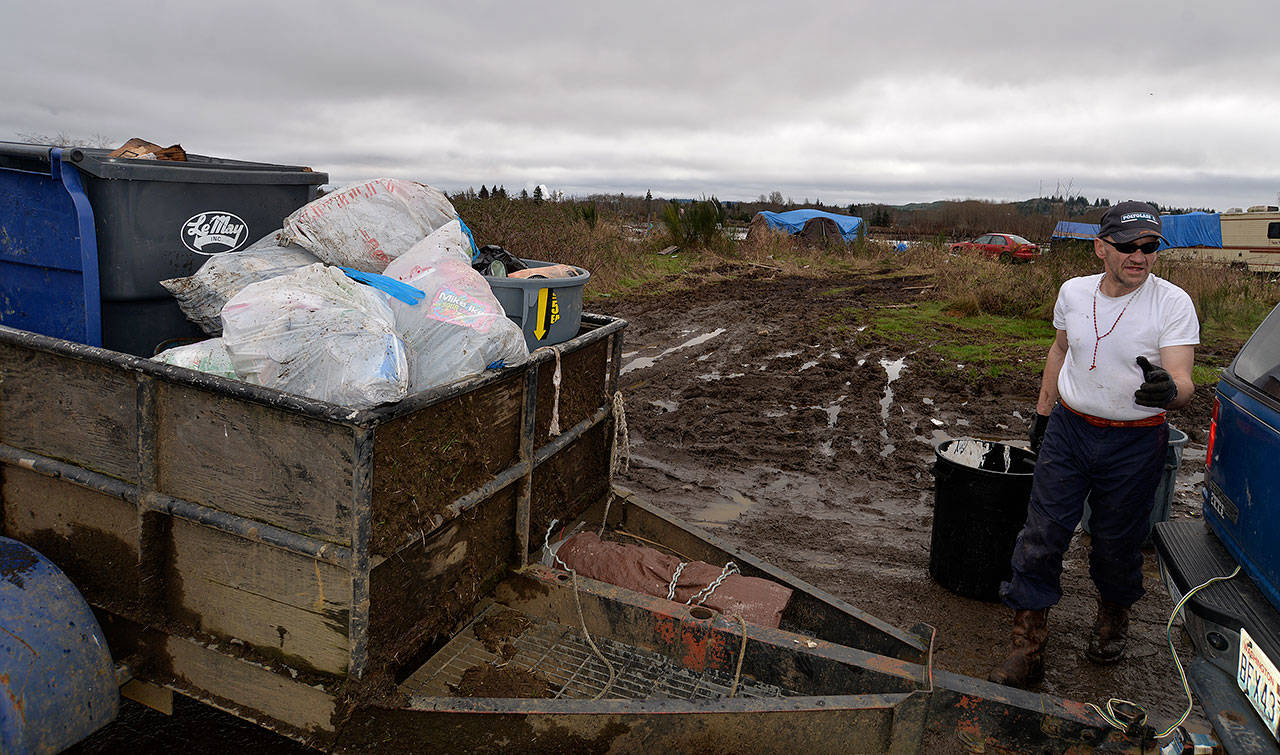Traveling west on River Street in Aberdeen, squeezing between a fenced-off empty plot of land and the train crossing by the needle exchange RV, Phil Calloway realizes he probably doesn’t have time to collect the trash this far up from the main camping area. There’s leftover food trash and bottles, but it’s not much compared to farther down the road.
The road is littered with potholes, and Calloway’s truck-pulled open trailer — which he uses as a makeshift garbage truck — creaks as it enters the long stretch of land along the Chehalis River where he estimates around 80 people live in tents and makeshift cabins. Calloway, who’s the executive director of the Revival of Grays Harbor homeless assistance program, has spent each Wednesday since July picking up thousands of pounds of trash from the riverside inhabitants.
“It’s been very helpful. Because oh my god, it has looked like a garbage dump at points here, just huge,” said Brett Hussey, 49, pointing to a mostly-clean section of grass next to the motorhome he lives in. “(Calloway) came by and kind of opened my eyes by cleaning, so I said I’d take care of it.”
Hussey, who has lived on the river for a month and a half with his fiancee, then gathers a couple bags, mostly ruined rugs, cans and miscellaneous plastic things, and dumps them in Calloway’s trailer. As the trailer drives along, some of the riverside campers are accustomed to bringing their trash out to the road, similar to a normal garbage truck route.
On his mid-day cleanup, Calloway is usually accompanied by Eldred Hamrick, who has been homeless himself and often volunteers for Revival. While Calloway drives the trailer, Hamrick does a lot of the dirty lifting, stomping through muddy driveways and sifting through bushes and rubble to find either a full bag of trash or an occasional can or bottle to throw in the trailer.
They stop at every major hub of tents, and not all the inhabitants are happy to see them. One man comes out and angrily says that Hamrick needs to stay out of his camp, and was messing with his social life.
After spending a few hours collecting on average 1,500 pounds of trash a week, which usually fills one or two trailer loads, Calloway drives to LeMay Grays Harbor to dump it off. Revival receives a quarterly $1,500 grant from Grays Harbor Community Foundation, which usually covers their dump fees, but they will sometimes go over that and use their own funds.
Along with sustaining a lower level of garbage among the camps, Calloway says his efforts are a way for him to more directly connect with the homeless people who are constantly moving in and out of the small community. By doing weekly trash cleanings since July, Calloway says a few people have been helped out of the camps and into better living situations.
“This seems to be the best way because it makes them acknowledge that we’re here to help them too, and we try to work on every one of them,” he said. “We’ve got a few people off the river right now who we’ve rehabilitated in the last few weeks.”
By spending hours here each Wednesday, Calloway also tries to prevent new young people from moving in, and tries to make sure they get out of the area.
The area near Hussey’s home typically has the most trash, Calloway says. It’s a circular cul-de-sac branch of the road, known to many there as the Reservation, due to a large number of tribal members who live there.
“There’s a lot of needle users here, and we usually pick up a lot of (needles) around here, some pretty nasty ones,” said Calloway, who notes that this year the number of campers has grown larger than he’s ever seen it.
One shelter has a large blue flag draped on the side with an intricate tribal design. In between it and the road are the charred remains of a structure that was burned down, with random garbage strewn among it.
However, not all of the numerous piles of garbage are intentional, Hussey says. Part of the reason for them is that collecting items, regardless of their functionality, is a measuring stick for social status he says.
“Status here, we were told from the beginning, is basically how many things you collect,” said Hussey. “Whoever has the most is on top. It is a communal place here, people generally help each other out. A lot of the people will give you the shirt off their backs, but they’ll also take it.”
As Hussey says this, a man on a bicycle rolls by, carrying a cracked Macintosh computer monitor and other plastic items on his back. He hasn’t had a lot of problems living there, but Hussey said he has had a gun pulled on him once, and has witnessed the deaths of some of his neighbors.
Calloway said he felt inspired to assist the homeless and join Revival more than a year ago after he noticed the large number of homeless people sleeping in the doorways of his downtown Aberdeen auto shop, and believes that finding more stable housing is the key to fixing the city’s homelessness problem.
Even though Revival works to find addiction treatment for homeless people who are using drugs, Calloway says it’s not going to make a big difference unless they can avoid coming down to places like the Chehalis riverfront that are prime spots to return to old habits.
“That’s the problem with kids like that,” Calloway said after speaking with someone new at the camps. “Yeah, he might want treatment in a few weeks, and then he’ll be right back here, because there’s nowhere to go.”




